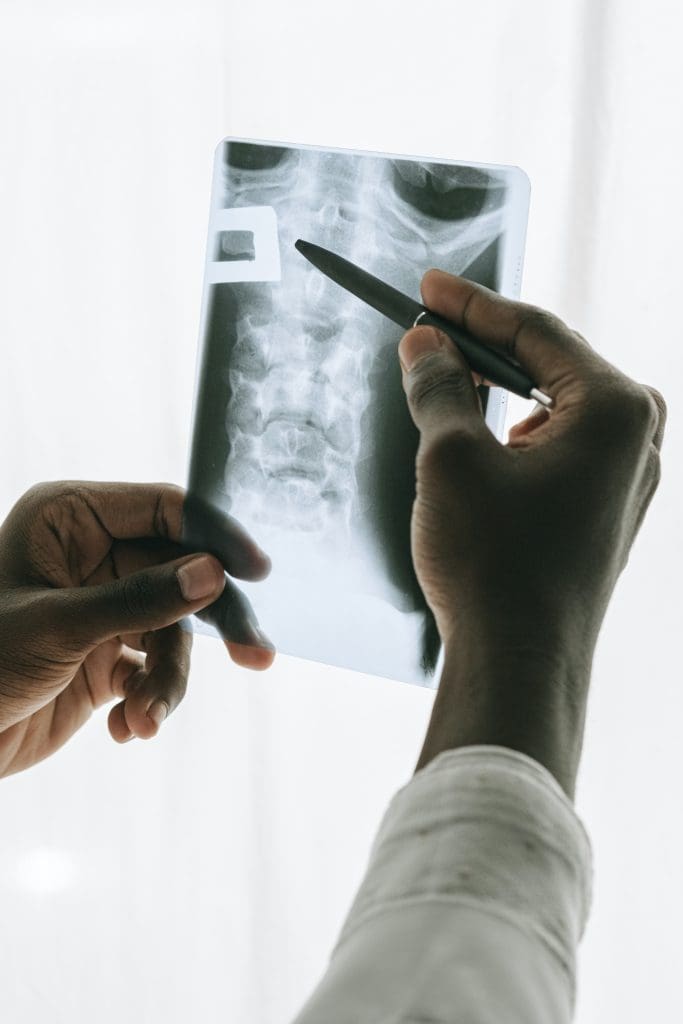Whiplash is a type of soft tissue injury that is caused by a sudden, forceful movement of the neck. This can result from a motor vehicle accident, a sports injury, or any activity that involves a sudden jerking of the head or neck.
Whiplash injuries can cause pain, soreness, and stiffness in the neck, shoulders and head. It can also lead to long-term disability and reduced quality of life.
This section will discuss the diagnosis and treatment of whiplash injuries as well as lifestyle modifications for recovery and prevention.
Whiplash injuries are most commonly caused by motor vehicle accidents, but may also result from contact sports, physical abuse, or any activity that involves a sudden jerking of the head or neck. The symptoms of whiplash can vary from mild to severe, and may include pain, stiffness, and headaches. It is important to diagnose and treat whiplash injuries as soon as possible to ensure a successful recovery.
Treatment may include rest, medication, physical therapy, and lifestyle modifications. Additionally, preventive measures can help reduce the risk of whiplash injuries.
Understanding the Impact of Whiplash
Traumatic acceleration-deceleration forces can lead to a range of physical and psychological effects, making it important to understand the impact of such an incident.
Whiplash is a term used to describe an injury to the neck caused by a sudden, forceful movement of the head. The most common cause of this type of injury is a car accident, but it can also result from other kinds of trauma such as a sports-related accident, a fall, or even a physical assault.
The pain and discomfort associated with whiplash can be severe and can range from a stiff neck to more severe symptoms such as headaches, dizziness, and blurred vision. In addition, some people may experience psychological symptoms, such as irritability, depression, or anxiety.
Treatment for whiplash typically involves pain medications, physical therapy, and massage. In some cases, surgery may be needed to repair any damage done to the neck. In most cases, however, the injury should heal within a few weeks with proper medical care.
It is important to note that recovery from whiplash can be a long and difficult process, and it is important to be patient and work with a healthcare provider to ensure a full and successful recovery.
Diagnosing Whiplash Injuries
The diagnosis of whiplash injuries typically involves a medical evaluation and physical examination to determine the extent of the injury.
Diagnostic tests such as X-rays and other imaging techniques may be used to help identify any associated fractures or other injuries that could be causing the pain.
Magnetic resonance imaging (MRI) is an imaging technique that is particularly useful in diagnosing whiplash injuries, as it can provide clear images of the soft tissue damage that often occurs in these cases.

Medical evaluation and physical examination
A medical evaluation and physical examination is essential for assessing the nature and extent of any trauma sustained. These exams seek to identify any structural damage to the spine, such as:
- Fractures:
- Compression fractures
- Burst fractures
- Dislocations:
- Complete dislocation
- Partial dislocation
Further, the medical evaluation and physical examination helps to identify any signs of neurological damage which could include: nerve root irritation, nerve entrapment, and muscle weakness.
Other tests, such as imaging studies, may be ordered to confirm suspected damage and to differentiate between soft tissue and bone injuries. Imaging studies such as X-rays and MRI scans can help to determine the severity of the whiplash injury.
Additionally, a physical examination may be used to assess range of motion, muscle spasm, and any associated pain. The physical examination is an important part of the medical evaluation, as it allows for the identification and treatment of any associated musculoskeletal injuries.
Diagnostic tests and imaging techniques
In order to accurately assess the extent of any trauma, a range of diagnostic tests and imaging techniques may be employed to confirm and differentiate between soft tissue and bone injuries.
Commonly used imaging techniques for evaluating whiplash injuries include X-rays, computed tomography (CT) scans, and magnetic resonance imaging (MRI). X-rays can detect bone fractures, but cannot provide much detail about the soft tissues. CT scans can provide detailed images of the bones, particularly in the neck, but also provide clear images of the soft tissues. MRI is the most sensitive imaging technique for detecting soft tissue injuries, such as muscle damage, ligament sprains, and disc herniation.
In addition to imaging techniques, laboratory tests may be used to evaluate the severity of whiplash injuries. These tests may include blood tests to measure levels of inflammation, as well as nerve conduction studies which measure the electrical activity of the nerves. These tests can help determine if there is any damage to the spinal cord or nerve roots. Other tests such as electromyography (EMG) can be used to measure the electrical activity of muscles and detect any signs of damage.
Treatments for Whiplash
Whiplash is a common injury, often caused by a rapid acceleration-deceleration force to the neck.
Treatments for whiplash vary depending on the severity of the injury and the patient’s individual needs.
Pain management strategies, physical therapy exercises and rehabilitation, chiropractic care, and alternative therapies are all potential treatments for whiplash injuries.
Pain management strategies (medication, heat therapy, etc.)
Pain management is a vital part of whiplash injury treatment, and various strategies, including medication, heat therapy, and more, can be employed to alleviate discomfort.
The most popular approaches to managing pain are:
- Medication: Over-the-counter medications, such as ibuprofen, acetaminophen, and naproxen, are often prescribed to reduce inflammation and provide pain relief.
- Heat Therapy: Applying heat to the affected area can help to reduce stiffness and muscle spasms, as well as promote relaxation.
- Cold Therapy: Cold therapy can be used to reduce inflammation and numb the area. It should be applied for 10-20 minutes at a time.
- Exercise: Exercise can help to strengthen the muscles around the affected area and improve range of motion, which can help to reduce pain.
Physical therapy exercises and rehabilitation
Physical therapy exercises and rehabilitation can be used to improve range of motion, strength, and flexibility in the affected area, ultimately helping to reduce pain associated with whiplash injuries. A physical therapist can help develop an individualized plan for recovery that includes stretching, strengthening, and range of motion exercises. Through physical therapy and rehabilitation, patients can learn to control their pain and prevent further injury.
Physical therapy and rehabilitation exercises are divided into four categories: stretching, strengthening, range of motion, and balance. Stretching exercises help to reduce muscle tension and improve flexibility. Strengthening exercises help to build muscle strength and endurance, while range of motion exercises help to increase flexibility and range of motion. Balance exercises help to improve coordination and stability.
| Exercises | Description |
| Stretching | Reduce muscle tension and improve flexibility |
| Strengthening | Build muscle strength and endurance |
| Range of Motion | Increase flexibility and range of motion |
| Balance | Improve coordination and stability |
Chiropractic care and alternative therapies
Chiropractic care and alternative therapies can provide an additional layer of support to aid in the management of whiplash-related pain and impairments.
This type of care typically focuses on spinal manipulation, which can be used to reduce pain and improve range of motion. In addition to spinal manipulation, chiropractors may also employ other treatments such as heat, cold, electrical stimulation, ultrasound, and massage.
A course of chiropractic therapy may be prescribed as a preventative measure to reduce the chance of further injury and to help accelerate the healing process.
Alternative therapies such as acupuncture, herbal medicine, and biofeedback can also be used to help manage pain and other symptoms of whiplash.
Acupuncture may be used to stimulate the body’s natural healing responses, while herbal medicine can be used to reduce inflammation and pain. Biofeedback can be used to help individuals learn how to control their own body functions, such as heart rate and muscle tension, which can in turn help reduce pain and promote relaxation.
It is important to discuss any and all treatments with a qualified healthcare provider before beginning any course of therapy.
Importance of Rest and Recovery
Whiplash injuries are common injuries that can have serious long-term effects if not properly managed and treated.
It is essential to understand the healing process for whiplash injuries in order to maximize recovery and prevent further injury.
Rest and activity modification recommendations are a key component of the healing process, and must be followed in order to allow the neck to heal and for the patient to safely transition into a gradual return to normal activities.

Understanding the healing process for whiplash injuries
The healing process for neck-related soft-tissue trauma is complex and requires a thorough understanding of the physiological changes that occur.
Whiplash injuries are often the result of a sudden and forceful movement of the neck that causes damage to the cervical muscles and ligaments.
The initial stages of healing involve inflammation, which helps to reduce further injury and clear debris that may be present. During this time, the body releases cytokines to help reduce swelling and pain.
The second stage of healing is the remodeling phase, during which scar tissue forms to help restore the injury site.
Once the injury site has been fully healed, the patient may still experience some residual discomfort, which can be managed with the help of a physical therapist.
Physical therapy exercises can help to strengthen the tissues, reduce pain, and improve range of motion.
Additionally, addressing emotional issues such as stress and anxiety can help to facilitate the healing process.
Rest and activity modification recommendations
Rest and activity modification are essential components of an effective plan for managing the symptoms of neck-related soft-tissue trauma. Early rest with activity modification is recommended to reduce the risk of further injury, reduce pain, and promote healing.
During the initial period of rest, activities should be limited to those that do not cause pain or increase the risk of further injury, such as:
- Low-impact activities:
- Light stretching
- Gentle range-of-motion exercises
- Walking
- Swimming
- High-impact activities:
- Heavy lifting
- Contact sports
- Running
Over time, more vigorous activities and exercises can be added to the plan. However, it is important to progress slowly and carefully, and to adjust the activity level according to the individual’s pain levels. Gradual increases in activity can help to strengthen the muscles and tissues around the neck and spine, while also helping to improve balance and coordination.
Additionally, the use of proper posture and body mechanics can help to reduce the risk of further injury and the likelihood of re-injury.
Gradual return to normal activities
Navigating a gradual return to normal activities after a soft-tissue trauma of the neck can be a challenging, yet rewarding, endeavor.
It is important to remember that recovery from a whiplash injury is not a linear process and that each individual’s healing timeline may be different.
To ensure a safe and successful return to normal activities, it is important to begin with lower-intensity exercises and gradually increase the demand on the body as the neck becomes stronger.
For example, a person may begin with light stretching and mobility exercises and then progress to more dynamic exercises such as walking, jogging, and running.
It is important to note that the progression of these exercises should be done in a careful and controlled manner to ensure that the neck is not overloaded.
Additionally, it is important to be mindful of any pain or discomfort that is experienced during the process and to adjust intensity levels accordingly to ensure that the neck is not further injured.
Lifestyle Modifications for Recovery
Ergonomics and proper posture are key aspects of any successful recovery from a whiplash injury.
Maintaining a healthy lifestyle is essential for promoting healing and strengthening the muscles and ligaments of the neck, shoulders and upper back.
Preventing future occurrences of whiplash can be achieved by following good posture and body mechanics, as well as avoiding activities that involve rapid, unexpected movements of the head and neck.
Ergonomics and proper posture
Improper posture can lead to a variety of physical ailments, making it essential to understand ergonomics to ensure optimal health.
Ergonomics is the science of designing the workplace and environment to fit the user. Specifically, it looks at how people interact with the tools and environment around them. This includes:
- Adjusting the height of chairs and desks to ensure comfort and good posture.
- Positioning of monitors to reduce neck strain.
- Utilizing supportive furniture to maintain proper spinal alignment.
Understanding ergonomics is important in preventing whiplash injuries. It can help to prevent the strain on neck muscles that can result in an injury.
Proper posture techniques not only reduce the risk of whiplash injuries but can also help with the recovery process. By understanding ergonomics, individuals can learn how to reduce the strain on their neck muscles and avoid further injury. Additionally, they can adjust their environment and work routine to maximize their comfort and safety.
Importance of maintaining a healthy lifestyle
Maintaining a healthy lifestyle is essential to staying fit, avoiding injury, and promoting overall wellbeing. This includes regular physical activity and exercise, a balanced diet, adequate sleep, and stress management. When it comes to whiplash injuries, which occur due to a sudden jolt or blow to the neck, a healthy lifestyle is particularly important for a speedy and successful recovery.
| Benefits of Healthy Lifestyle | Potential Risks of Unhealthy Lifestyle |
| Improved wellbeing | Chronic health conditions |
| Reduced stress | Musculoskeletal injuries |
| Lower risk of injury | Poor mental health |
| Increased physical strength | Reduced productivity |
| Improved sleep quality | Weakened immune system |
A healthy lifestyle can help individuals avoid injuries, such as whiplash, by strengthening their muscles and increasing their overall physical fitness. At the same time, unhealthy habits can increase the likelihood of sustaining an injury due to weakened muscles and decreased physical fitness. Additionally, a balanced diet and sufficient sleep can help improve the recovery process by providing the body with the necessary nutrition and rest it needs to heal.
Tips for preventing future whiplash injuries
The importance of maintaining a healthy lifestyle to aid in the recovery of whiplash injuries is undeniable. However, it is just as important to take preventative measures to ensure whiplash injuries do not occur in the first place.
Prevention is key to avoiding the pain associated with whiplash injuries, and there are several tips for preventing future whiplash injuries.
To start, it is important to ensure that one is using the proper safety precautions when participating in activities that may be associated with whiplash injuries, such as sports or activities involving physical contact. This includes wearing appropriate safety gear, such as helmets or neck braces.
Additionally, it is important to maintain proper posture while participating in physical activity to avoid injury. It is also important to be aware of one’s surroundings and to take caution when engaging in any activity that involves physical contact.
Lastly, it is important to properly warm up and stretch before engaging in physical activity to reduce the chance of injury.
Following these tips can help reduce the risk of whiplash injuries and ensure a safe and healthy lifestyle.
Preventing Whiplash Injuries
When considering how to prevent whiplash injuries, it is important to consider safe driving practices and defensive driving tips, as well as the proper use of seat belts and headrests, and the importance of maintaining a well-fitted car seat.
To ensure safety when driving, drivers should follow the rules of the road, drive defensively, and maintain a safe speed.
Additionally, the use of seatbelts and headrests should be done properly and checked regularly to ensure they are in the correct position.
Finally, it is essential to keep car seats properly adjusted and fitted to avoid whiplash injuries.

Safe driving practices and defensive driving tips
Practicing safe driving techniques and employing defensive driving strategies can help reduce the risk of potential motor vehicle collisions.
Defensive driving is a set of driving skills that allow a person to anticipate dangerous situations and respond to them in a safe and effective manner. This includes maintaining a safe speed, obeying traffic laws, avoiding distractions, paying attention to the surrounding environment, and being aware of other drivers’ possible intentions.
Safe driving techniques should be used at all times while driving, regardless of the type of road, weather conditions, or time of day. This includes keeping a safe following distance, avoiding aggressive driving behaviors, such as sudden acceleration or abrupt lane changes, and avoiding driving while impaired.
Additionally, drivers should always wear their seat belts, as this can reduce the risk of whiplash and other serious injuries in the event of a collision.
Proper use of seat belts and headrests
Adequate use of seat belts and headrests can help to minimize trauma sustained in the event of a motor vehicle collision. Seat belts are designed to keep occupants securely in their seats, reducing the risk of ejection and the potential for trauma to other parts of the body.
Headrests are designed to provide additional protection against whiplash, which is a common injury sustained in rear-end collisions. Proper use of seat belts requires that the wearer ensures that the belt is securely fastened across their hips and chest, and that the shoulder strap is not tucked behind them.
The headrest should be properly adjusted to a height that is equal to the top of the head when seated.
When properly used, the seat belt and headrest provide the occupants of a vehicle with a measure of protection from the force of a collision.
It is important to remember, however, that the use of these safety devices does not guarantee complete protection from injury. It is still possible for a vehicle occupant to suffer a whiplash injury even with the use of these devices.
It is important to ensure that both seat belts and headrests are correctly adjusted before driving to maximize the safety they offer.
Importance of maintaining a well-fitted car seat
Following proper use of seat belts and headrests, it is also important to maintain a well-fitted car seat in order to reduce the risk of whiplash injuries.
A well-fitted car seat is an essential component of safe driving, as it ensures that the occupant of the seat is properly supported in the event of a collision. This is especially important for smaller occupants, such as children and the elderly, who may not be able to withstand the force of a collision as well as an adult.
A well-fitted car seat should be adjusted to the appropriate height for the occupant and should be secured tightly. The shoulder straps should be positioned at shoulder level and the lap belt should fit snugly across the hips and not across the stomach.
It is also important to ensure that the car seat is suitable for the age and size of the occupant. If the car seat is too loose, it can slide around during a collision, leading to a higher risk of whiplash injury.
In addition, regular maintenance of the car seat is essential to ensure it is in good condition and is providing the necessary support.
Conclusion
Whiplash is a painful, debilitating injury that can have long-lasting effects. To ensure a full recovery, it is important for those suffering from whiplash to receive an accurate diagnosis and access to appropriate treatments.
Rest is key for recovery, as is making lifestyle modifications that support the healing process. Knowledge of the risks and prevention measures is also essential for avoiding future whiplash injuries.
With the right approach, those affected by whiplash can gain the relief they need and make a successful return to their normal activities. Whiplash is an injury that should not be taken lightly. Understanding the range of treatments available, making lifestyle changes, and taking preventative measures can help individuals to manage the pain and discomfort associated with whiplash and make a full recovery.
Since whiplash is a complex condition, it is crucial to consult a doctor with expertise in treating such injuries. Contact 1-800-Ask-Gary for a complimentary consultation or to receive a medical referral.


